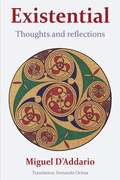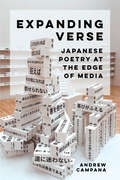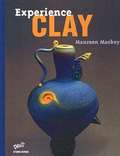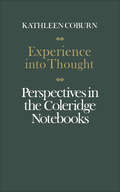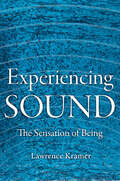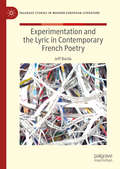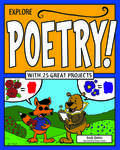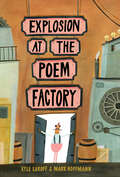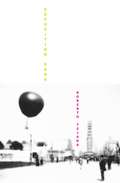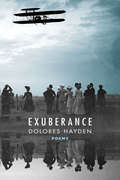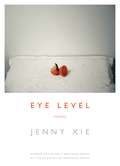- Table View
- List View
Existential, thoughts and reflections
by Miguel D'AddarioCompilation of writings and reflections form diverse themes and existential subjects. These are thoughts that take to analysis and observation of the words. A summary of texts that will make us see an alternative road of the usually written before. To think and meditate.
Exit Opera: Poems
by Kim AddonizioA new volume by acclaimed poet Kim Addonizio, whose work is known for its streetwise, unflinching explorations of love, lust, and mortality. Set in locations from dive bars to Montparnasse Cemetery, from an ancient Greek temple to a tourist shop in Assisi, Exit Opera explores the ever-vexing issues of time, mortality, love, and loss, and considers the roles of art and human connection. Whatever their nominal subject—jazz, zombies, Buddhism, Siberian tigers—these poems make for a compelling mix of humor and pain, difficulty and solace. In a nod to Keats, one of the many fellow travelers in these poems, Addonizio invites us to “[inscribe] a few verses on whatever water / you can find” and assures readers that they are not alone in navigating the challenges and changes of mortal life. As she writes in “My Opera”: The staging is difficult. Exploding stars are involved, high-redshift galaxies, interior chambers, a little country blues, a little jazz guitar, a jam jar containing a tiny ocean & a tinier rowboat rocking gently in the swells that I am steering toward you in the dark.
Exits and Entrances: Selected Poems
by Paul HollingworthExits and Entrances is a selection of poems, spanning four decades, by Paul Hollingworth. Hollingworth incorporates different styles from lyricism, elegy, and rap influences to enhance a resonant statement on varied subjects such as birth and loss, psychosis, redemption, technology, the financial sector, social disorder, and a favourite film or song. Location is important to his work. Hollingworth takes the reader on a journey to the high Andes of Peru and Chile, to Glasgow, to Canvey Estuary, and to a family home in Andalucia.
Exodus (African Poetry Book)
by ‘Gbenga AdeobaWinner of the Sillerman First Book Prize for African Poetry, &‘Gbenga Adeoba&’s collection Exodus focuses on forms of migration due to the slave trade, war, natural disasters, and economic opportunities. Using the sea as a source of language and metaphor, Adeoba explores themes of memory, transition, and the intersections between the historic and the imagined. With great tenderness and power his poetry of empathy searches for meaning in sharply constructed images, creating scenes of making and unmaking while he investigates experiences of exile and displacement across time and place.
Expanding Verse: Japanese Poetry at the Edge of Media (New Interventions in Japanese Studies #6)
by Andrew CampanaA free ebook version of this title is available through Luminos, University of California Press's Open Access publishing program. Visit www.luminosoa.org to learn more.Expanding Verse explores experimental poetic practice at key moments of transition in Japan's media landscape from the 1920s to the present. Andrew Campana centers hybrid poetic forms in modern and contemporary Japan—many of which have never been examined in detail before—including the cinepoem, the tape recorder poem, the protest performance poem, the music video poem, the online sign language poem, and the augmented reality poem. Drawing together approaches from literary, media, and disability studies, he contends that poetry actively aimed to disrupt the norms of media in each era. For the poets in Expanding Verse, poetry was not a medium in and of itself but a way to push back against what new media technologies crystallized and perpetuated. Their aim was to challenge dominant conceptions of embodiment and sensation, as well as who counts as a poet and what counts as poetry. Over and over, poetic practice became a way to think about each medium otherwise, and to find new possibilities at the edge of media.
Expectation Days (Illinois Poetry Series)
by Sandra McPhersonFrom movie making to medical misadventures, meditations on widowhood to feminist protestations, Expectation Days is a dazzling portrayal of instances in Sandra McPherson’s life. Her autobiographical collection uses peculiar and exact language to reflect on a wide range of activities that include grouse hunting, going through airport security after 9/11, and climbing a coastal cliff. From being an unintended child to ceremonializing a lifetime “served,” McPherson speaks in both clear and distressing voices from the state of speechless fear that is bereavement. Will the little figures ever reach the monument? A doctor orders me to be on watch. Will the mist pass over their cheeks and clear the strollers’ eyes? If so, I’ll see it. I’m on watch. I train my eyes on paintings to see if there is any change. --from “On Suicide Watch”
Experience Clay
by Maureen MackeyLEVEL: 6th form onwards. This contemporary guide to clay techniques, tools, and traditions is as inspirational as it is practical. Supported by a clear, step-by-step illustrations, this comprehensive resource details a range of hand building and wheel throwing techniques. From the properties of clay to decoration and firing, all information presented is shown against a rich backdrop of dynamic professional and student work. While encouraging students of varying abilities to explore their own unique style and interests, basic to advanced studio opportunities highlight teaching tips and safety notes at point of use. Friendly and definitive, this stimulating guide to clay is ideal as an introductory text for a studio course from Art I to Ceramics IV. The student text explores ancient traditions and historic innovations. It also includes carefully crafted lessons organised for success in creating art and mastering key concepts and skills while introducing students to: Contemporary masters; Cutting-edge works of art; New media; Techniques and safety precautions; Current careers in art.
Experience Clay
by Maureen MackeyLEVEL: 6th form onwards. This contemporary guide to clay techniques, tools, and traditions is as inspirational as it is practical. Supported by a clear, step-by-step illustrations, this comprehensive resource details a range of hand building and wheel throwing techniques. From the properties of clay to decoration and firing, all information presented is shown against a rich backdrop of dynamic professional and student work. While encouraging students of varying abilities to explore their own unique style and interests, basic to advanced studio opportunities highlight teaching tips and safety notes at point of use. Friendly and definitive, this stimulating guide to clay is ideal as an introductory text for a studio course from Art I to Ceramics IV. The student text explores ancient traditions and historic innovations. It also includes carefully crafted lessons organised for success in creating art and mastering key concepts and skills while introducing students to: Contemporary masters; Cutting-edge works of art; New media; Techniques and safety precautions; Current careers in art.
Experience into Thought: Perspectives in the Coleridge Notebooks
by Kathleen CoburnColeridge is admired as a genius and derided as an opium addict and plagiarist. The aim here has been to examine his experiences, moods, thoughts, and reactions as a whole and their relation to poems such as Christabel, the Ancient Mariner, and the Dejection ode, and to his prose works, and also to look at many of his own statements made mainly in the privacy of his notebooks about his aims and purposes. The result of the new compound should alter some of the uninformed and prejudiced generalizations about Coleridge. The new picture is of a man and poet more human, more inquiring, more sceptical, whose strength and intellectual stature can fully be understood only against a background of suffering and loneliness; a critical, radical imagination is seen not only struggling to survive but to achieve creatively in the process.One of the world's pre-eminent Coleridge scholars, Kathleen Coburn brings a long association with and intimate knowledge of Coleridge's writings, both published and unpublished, to this sensitive study of a complex mind and personality.
Experiencing Sound: The Sensation of Being
by Lawrence KramerFrom the winds of Mars to a baby's first laugh, a prolific philosopher-composer reflects on the profound imperative of sound in everyday life. Experiencing Sound presents its subject as fundamental to all experience—sensation, perception, and understanding. Lawrence Kramer turns on its head the widespread notion that vision takes pride of place among the senses and demonstrates how paying attention to sound can transform how we make meaning out of experience. Through a series of brief, lyrical forays, Kramer shows that sound, whether heard or unheard, is the object of a primary need and an essential component in the sensation of being alive and the perception of time. It is something that we may suffer—or be made to suffer—as well as enjoy. Like its predecessor The Hum of the World, this book ranges widely across music, philosophy, literature, art, media, and history, from classical antiquity to the present, as it invites us to experience sound anew.
Experimentation and the Lyric in Contemporary French Poetry: Poetry On The Edge (Palgrave Studies in Modern European Literature)
by Jeff BardaExperimentation and the Lyric in Contemporary French Poetry offers a new theoretical approach and historical perspective on the remarkable upsurge in creative poetic practices in France that have challenged traditional definitions of poetry and of the lyric. Focusing on the work of Pierre Alferi, Olivier Cadiot, Emmanuel Hocquard, Franck Leibovici, Anne Portugal and Denis Roche, this book provides an analysis of the most influential poets in French poetry of the last few decades. It contextualizes the theoretical models that inform their investigations, analyzing them alongside the history of the avant-garde and the heated theoretical debates that have taken place over whether to continue or bring an end to the lyric. Systematically addressing the various strategies employed by these poets and drawing on reception theory and cognitive studies, Jeff Barda argues that French radical poetics re-evaluates the lyric in cognitive terms beyond the personal. This book is essential reading for anyone interested in twenty-first-century forms of experimental writing and the connections between literature and the arts today.
Explorations in Literature (America Reads)
by Ruth S. Cohen Raymond J. Rodrigues Nancy MillettExplorations in Literature presents a compilation of stories, poems, and essays from different authors and genres grouped by theme to create critical thinking skills. In addition to teaching literary terms, the questions in the book develop the students' abilities to respond to literature.
Explorations in Literature (America Reads) Classic Edition
by Nancy C. Millett Raymond J. Rodrigues'Explorations in Literature' has six units containing short stories, poetry, plays, and nonfiction. A seventh unit is made up of Greek myths. The eighth unit consists of a novel, The Call of the Wild.
Explore Poetry!
by Andi DiehnPoems can be silly, serious, or fun, just like kids! Whether it’s the sing-song rhythm of a limerick, the serendipitous magic of a found poem, the deceptive simplicity of a haiku, or the easy familiarity of an acrostic poem, children are charmed by poetry. And what’s more fun than reading poetry? Writing it! In Explore Poetry! With 25 Great Projects children have fun learning about different forms of poetry while delving into different literary techniques such as personification, metaphor, and alliteration, all of which are discussed in a simple and accessible way. Activities include creative writing exercises designed to reinforce language arts skills, plus art projects that encourage children to visualize concepts and definitions. Short biographies of important poets reinforce the concept of poetry as an important part of society. Explore Poetry! meets Common Core State Standards for language arts; Guided Reading Levels and Lexile measurements indicate grade level and text complexity. Informational and inspiring, Explore Poetry! fits seamlessly into the poetry curriculum of grades 2 to 4 and serves as an enrichment resource all during the school year, especially April, Poetry Month.
Explosion at the Poem Factory
by Kyle LukoffA funny story, full of wordplay, brings poetry alive as never before! Kilmer Watts makes his living teaching piano lessons, but when automatic pianos arrive in town, he realizes he’s out of a job. He spots a “Help Wanted” sign at the poem factory and decides to investigate — he’s always been curious about how poems are made. The foreman explains that machines and assembly lines are used for poetry these days. So Kilmer learns how to operate the “meter meter” and empty the “cliché bins.” He assembles a poem by picking out a rhyme scheme, sprinkling in some similes and adding alliteration. But one day the machines malfunction, and there is a dramatic explosion at the poem factory. How will poetry ever survive? Kyle Lukoff’s funny story, rich in wordplay, is complemented by Mark Hoffmann’s lively, quirky art. The backmatter includes definitions of poetic feet, types of poems (with illustrated examples) and a glossary of other terms. An author’s note explains the inspiration for the story. Key Text Features definitions glossary author's note Correlates to the Common Core State Standards in English Language Arts: CCSS.ELA-LITERACY.RL.2.4 Describe how words and phrases (e.g., regular beats, alliteration, rhymes, repeated lines) supply rhythm and meaning in a story, poem, or song.
Exposition Park (The Driftless Series)
by Roberto TejadaImagine a walking tour of stanzas and prose poems that give lyric voice to sight, public speech, and spectacle. In Exhibition Park, Roberto Tejada delivers a command performance in mixed genres that compel an array of literary styles. His poetry undertakes a wide range of subjects motivated by artworks from Latin America and the United States covering the colonial period to the present day. In serial poems, short sketches, guidebook parodies, painterly triptychs, translations, and other word-based dioramas, Tejada coins wonder with historical styles--baroque, classic, and experimental. As likened to a world's fair, the resulting voices intone global stories, the dream life of art, and first-person atmospheres both premodern and postindustrial. "Tejada's work is with dismantling borders and upsetting classifications... The result is a layered poetry that finds its form in dense stanzas composed of lines that frequently veer toward a kind of fractured prose..."--Alan Gilbert in Another Future: Poetry and Modern Art in a Postmodern Twilight"You walk through his world as a voyeur, a traveler of mirrors, witnessing your own reflection in the masses of flesh, simultaneously aroused and disturbed at the same time. Tejada's work is an invitation, a window into another world, unabashedly erotic, and succinct."--Christine Lark Fox, Poetry Project Newsletter, about Mirrors for Gold
Expounding the Doubtful Points
by Wing T. LumThis collection of poems discusses the author's Chinese-American heritage. Themes present include: ancestral ties to China, living family members in Hawaii and ugly stereotyping.
Expressway
by Sina QueyrasNominated for the 2009 Governor General's Award for Poetry.This poem resembles urban sprawl. This poem resembles the freedom to charge a fee. The fee occurs in the gaps. It is an event. It is not without precedent. It is a moment in which you pay money. It is a tribute to freedom of choice. Reality is a parking lot in Qatar. Reality is an airstrip in Malawi. Meanwhile the expressway encloses, the expressway round and around the perimeters like wagon trains circling the bonfire, all of them, guns pointed, Busby Berkeley in the night sky. Expressway exposes the paradox of modern mobility: the more roads and connections we build, the more separate we feel. Sina Queyras has written a bravely lyrical critique of our ethical and ecological imprint, a legacy easily blamed on corporations and commerce, but one we've allowed, through our tacit acquiescence, to overwhelm us. Every brush stroke, every bolt, and nut, every form and curve in our networks of oil and rubber, every thought and its material outcome - each decision can make or unmake us.
Extra Hidden Life, among the Days (Wesleyan Poetry Series)
by Brenda HillmanBrenda Hillman begins her new book in a place of mourning and listening that is deeply transformative. By turns plain and transcendent, these poems meditate on trees, bacteria, wasps, buildings, roots, and stars, ending with twinned elegies and poems of praise that open into spaces that are both magical and archetypal for human imagination: forests and seashores. As always, Hillman's vision is entirely original, her forms inventive and playful. At times the language turns feral as the poet feels her way toward other consciousnesses, into planetary time. This is poetry as a discipline of love and service to the world, whose lines shepherd us through grief and into an ethics of active resistance. Hillman's prior books include Practical Water and Seasonal Works with Letters on Fire, which received the Griffin Prize for Poetry. Extra Hidden Life, Among the Days is a visionary and critically important work for our time. A free reader's companion is available online at http://brendahillman.site.wesleyan.edu.
Extracting the Stone of Madness: Poems 1962 - 1972
by Alejandra Pizarnik Yvette SiegertThe first full-length collection in English by one of Latin America's most significant twentieth-century poets. Revered by the likes of Octavio Paz and Roberto Bolano, Alejandra Pizarnik is still a hidden treasure in the U.S. Extracting the Stone of Madness: Poems 1962-1972 comprises all of her middle to late work, as well as a selection of posthumously published verse. Obsessed with themes of solitude, childhood, madness and death, Pizarnik explored the shifting valences of the self and the border between speech and silence. In her own words, she was drawn to "the suffering of Baudelaire, the suicide of Nerval, the premature silence of Rimbaud, the mysterious and fleeting presence of Lautréamont," as well as to the "unparalleled intensity" of Artaud's "physical and moral suffering."
Extreme Poetry: The South Asian Movement of Simultaneous Narration
by Yigal BronnerBeginning in the sixth century C.E. and continuing for more than a thousand years, an extraordinary poetic practice was the trademark of a major literary movement in South Asia. Authors invented a special language to depict both the apparent and hidden sides of disguised or dual characters, and then used it to narrate India's major epics, the Ramayana and the Mahabharata, simultaneously. Originally produced in Sanskrit, these dual narratives eventually worked their way into regional languages, especially Telugu and Tamil, and other artistic media, such as sculpture. Scholars have long dismissed simultaneous narration as a mere curiosity, if not a sign of cultural decline in medieval India. Yet Yigal Bronner's Extreme Poetry effectively negates this position, proving that, far from being a meaningless pastime, this intricate, "bitextual" technique both transcended and reinvented Sanskrit literary expression. The poems of simultaneous narration teased and estranged existing convention and showcased the interrelations between the tradition's foundational texts. By focusing on these achievements and their reverberations through time, Bronner rewrites the history of Sanskrit literature and its aesthetic goals. He also expands on contemporary theories of intertextuality, which have been largely confined to Western texts and practices.
Extreme Poetry: The South Asian Movement of Simultaneous Narration (South Asia Across the Disciplines)
by Michael BronnerBeginning in the sixth century C.E. and continuing for more than a thousand years, an extraordinary poetic practice was the trademark of a major literary movement in South Asia. Authors invented a special language to depict both the apparent and hidden sides of disguised or dual characters, and then used it to narrate India's major epics, the Ramayana and the Mahabharata, simultaneously.Originally produced in Sanskrit, these dual narratives eventually worked their way into regional languages, especially Telugu and Tamil, and other artistic media, such as sculpture. Scholars have long dismissed simultaneous narration as a mere curiosity, if not a sign of cultural decline in medieval India. Yet Yigal Bronner's Extreme Poetry effectively negates this position, proving that, far from being a meaningless pastime, this intricate, "bitextual" technique both transcended and reinvented Sanskrit literary expression.The poems of simultaneous narration teased and estranged existing convention and showcased the interrelations between the tradition's foundational texts. By focusing on these achievements and their reverberations through time, Bronner rewrites the history of Sanskrit literature and its aesthetic goals. He also expands on contemporary theories of intertextuality, which have been largely confined to Western texts and practices.
Exuberance: Poems
by Dolores HaydenTake flight with these dazzling persona poems telling the stories of daredevil pilots in the early days of aviation—from the author of American Yard. Daredevil pilots Lincoln Beachey, Betty Scott, Harriet Quimby, Ruth Law, Ormer Locklear, Bessie Coleman, and Clyde Pangborn fly at carnival altitudes to thrill millions of spectators who have never seen an airplane. In a lyrical sequence of persona poems, the pilots in Exuberance wonder how the experience of moving through the air will transform life on the ground. They learn to name the clouds, size up the winds, mix an Aviation Cocktail, perform a strange field landing, and make an emergency jump.&“Intoxicated with the history of aviation, Dolores Hayden has written a work of historical imagination that is vocally energetic, psychologically acute, and musically sophisticated. . . . The movement between lyrical speech and historical reflection gives us not only a portrait of the early years of the twentieth century, but a book in which technological advance is given a profoundly human voice.&” —Tom Sleigh, poet, dramatist, essayist, author of House of Fact, House of Ruin &“Exuberance is the word for this expansive and exciting collection, and also the word for the vanished earliest days of aviation it evokes, when flying was entertainment and adventure, not everyday transportation. Hayden brings to life a rollicking cast of birdmen and birdwomen, showmen and stunt pilots, producers and profiteers—and their entranced audiences and riders too. . . . Hayden&’s lush and energetic poems give us earthbound readers, used to shuttling from airport to airport, a sense of what that intoxication must have felt like.&” —Katha Pollitt, poet and columnist, author of The Mind-Body Problem
Eye Level: Poems
by Jenny XieFINALIST FOR THE NATIONAL BOOK AWARD FOR POETRYWinner of the Walt Whitman Award of the Academy of American Poets, selected by Juan Felipe HerreraFor years now, I’ve been using the wrong palette.Each year with its itchy blue, as the bruise of solitude reaches its expiration date.Planes and buses, guesthouse to guesthouse.I’ve gotten to where I am by dint of my poor eyesight,my overreactive motion sickness.9 p.m., Hanoi’s Old Quarter: duck porridge and plum wine. Voices outside the door come to a soft boil.—from “Phnom Penh Diptych: Dry Season”Jenny Xie’s award-winning debut, Eye Level, takes us far and near, to Phnom Penh, Corfu, Hanoi, New York, and elsewhere, as we travel closer and closer to the acutely felt solitude that centers this searching, moving collection. Animated by a restless inner questioning, these poems meditate on the forces that moor the self and set it in motion, from immigration to travel to estranging losses and departures. The sensual worlds here—colors, smells, tastes, and changing landscapes—bring to life questions about the self as seer and the self as seen. As Xie writes, “Me? I’m just here in my traveler’s clothes, trying on each passing town for size.” Her taut, elusive poems exult in a life simultaneously crowded and quiet, caught in between things and places, and never quite entirely at home. Xie is a poet of extraordinary perception—both to the tangible world and to “all that is untouchable as far as the eye can reach.”
